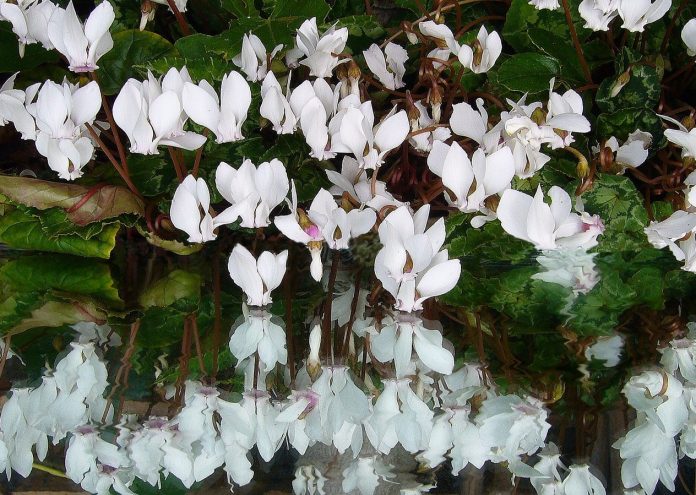
As we approach the holiday season I have gifts on my mind. Gardener friends are easier to buy for than non-gardeners, in my experience, as they are usually pleased with a live gift. As for myself, if it is colourful and lasts a few weeks, I am delighted. It being Christmas soon, our choices are not limited to the always popular Poinsettia (now available in an amazing array of shades), Christmas cactus and Amarylis bulb (also available in many shapes and colours). This year I will be in search of flowering plants not so seasonal, but beautiful nevertheless.
Cyclamen persicum, also known as Florist’s cyclamen, are available in stores and garden centres and make lovely gifts. Varieties range from mini to medium to very large; colours range from pure white through all the warm shades of pink, fuschia and red. The blooms stand up perkily above the foliage (roundish or heart shaped leaves, with attractive patterns) and bend over to look down. Choose one that looks healthy and has many unopened buds. Like so many of our house plants, the original cyclamen grows wild in the Mediterranean countries, and have been hybridized for our indoor enjoyment. In their natural home, they grow on hillsides among rocks, coming into bloom in the cooler months of winter and spring, and going dormant during the heat of summer and fall. Ours have been forced into bloom for our convenience by controlled environments in greenhouses. As long as you respect their need for a cooler space with light (no hot sun), and good drainage, your plant should be happy for weeks and even months. A tray with rocks and water for humidity is always appreciated, but do not let the pot touch the water. When quite dry, soak the pot in a few inches of water, allowing it to rehydrate, drain, and replace in its bright location. Watering from the top is risky as the concave top of the corm will rot if it gets wet too often. Your cyclamen will automatically go dormant when it has finished blooming, its leaves turning yellow, and no new growth in evidence. This is perfectly normal—you didn’t kill it. Many people now discard it and move on to something else. If you are determined to rejuvenate it, however, you must put it (pot and all) in a cool dry place and pretend it is under a Mediterranean rock for a few months. In the fall, lift the corm, repot it in good potting soil and begin watering again. I haven’t done this, but the books say it is possible.
Kalanchoe bossfeldana (cousin of the Jade plant) is a low maintenance succulent. Unlike the cyclamen who wants to be cool, kalanchoe thrives in a warm sun-filled window. No humidity tray is needed, just water when dry and thoroughly drain. Succulents are more often killed by too much water than by too little. Clusters of blooms (white through yellow, orange and red) on upright stems will last for months, and if you want to try a second time, water less for a few months and give it a rest. The experts say you must do the “dark closet” thing for 12 hours a day to trick it into thinking the season has changed (kalanchoe, like poinsettia and Christmas cactus are photoperiodic plants); I have found, though, that our change of daylight hours at this latitude does the job without any closets involved. You just need to accept that the plant will bloom on its own schedule, not yours. My Christmas cactus are all in full bloom in October and November, despite their name. (I have seen them called “Holiday Cactus” in some places—a more appropriate label.)
In search of a friendly garden club? Queensland Garden Club meets the first Wednesday of each month at the Queensland Community Centre at 7:00 pm.
All are welcome, and we don’t care where you live.









